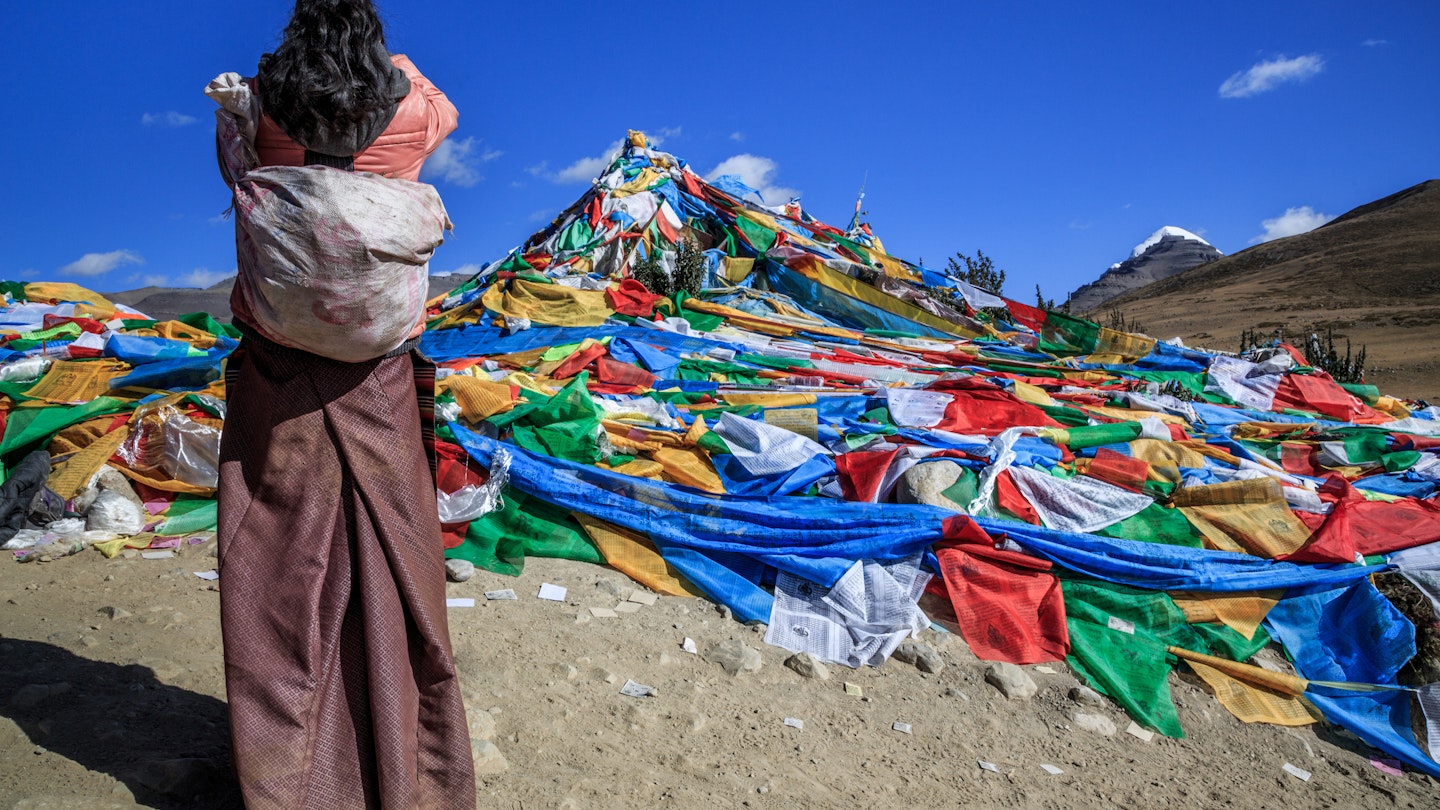Mount Kailash: A Sacred Journey
Sacred to over a billion Buddhists, Hindus, and Jains, enigmatic Mount Kailash is quite possibly the world’s holiest mountain. Pilgrims from across Asia trek across the spectacular high-altitude landscape of remote Western Tibet to pay homage and walk around the sacred mountain. It is one of the world’s great overland trips and, despite the altitude, is surprisingly accessible.

Kailash (Kang Rinpoche, or ‘Precious Snow Mountain’ in Tibetan) derives much of its significance from its striking physical location, a lone peak detached from the main Himalayan range in Tibet’s Kangdise mountains. The mountain rises sheer from the surrounding plain, presenting its four faces to the cardinal directions. From its foothills spring the sources of four of Asia’s greatest rivers: the Indus, Sutlej, Brahmaputra (Yarlung Tsangpo), and Karnali (which flows into the Ganges).
For Tibetans, this is where the Tantric magician Milarepa vanquished his Bön (Tibetan folk religion) rival Naro Bönchung in an epic battle, affirming Buddhism’s dominance over the existing Bön religion. For Hindus, Kailash is the abode of Shiva and his consort Parvati. Both Buddhists and Hindus view Kailash as the mythical Mount Meru, the universe’s central axis. Due to the sanctity of the 6474m peak, it remains unclimbed to this day.

Walking the Pilgrimage Circuit
The three-day clockwise walk around Mt Kailash is one of Asia’s classic treks. It isn’t particularly strenuous; however, it does take you to high altitudes, starting at 4670m and peaking at 5650m at the Drölma-La pass, necessitating good acclimatization and physical fitness. Days are not overly long—the first and third days essentially function as half days. Moreover, you can hire local yaks or porters to carry your gear. Accommodation options include camping or overnight stays in simple lodgings at local monasteries.
Walking alongside Tibetan nomads, Indian tourists, and Bön pilgrims (who travel anti-clockwise), you will pass several monasteries and sacred sites marked by rocks carved with stone mantras. The spiritual significance of Kailash is profound; many believe a single circuit, known as the kora, can erase the sins of a lifetime. At Shiva-tsal, visitors often leave behind mementos—items of clothing or locks of hair—symbolizing the life they are leaving behind.
Hard-core pilgrims often aim for 108 circuits, some methodically performing full body prostrations along the journey. Ultimately, a trek around Kailash represents as much a spiritual pilgrimage as it does a physical challenge.
The most popular time for this pilgrimage coincides with the Saga Dawa festival, typically held from May to June. During this period, thousands of pilgrims, alongside numerous tourists, gather to celebrate Buddha’s enlightenment. A sizable prayer pole is erected with great celebration at Tarboche, marking the beginning of the trek for many. It is advisable to check the political situation before planning a trip during the festival, as the region can occasionally close to foreign visitors due to concerns over pro-Tibetan demonstrations.
How to Reach Mount Kailash
The most effective way to reach Mount Kailash is to fly or take a train to Lhasa from China or Kathmandu. Spending a couple of days acclimating there is beneficial before beginning the four-day drive to the mountain in far Western Tibet. Along the way, you can stop at the Tibetan town of Shigatse and the ancient Sakya monastery. Furthermore, there is an opportunity to detour to the breathtaking north face of Everest Base Camp, albeit requiring an additional two days. In recent years, roads leading to Western Tibet have improved, making for a more comfortable and scenic journey.
Upon returning from Western Tibet, you might wish to be dropped off at the Nepal border at Rasuwagadhi, a day’s drive from Kathmandu. This descent takes you through the stunning Alpine-style Kyirong Valley, transitioning from the high Tibetan plateau to the Indian subcontinent. Overall, expect to budget for a 17- to 21-day road trip, depending on your unique itinerary.
Exploring the Surrounding Area of Kailash
At the foot of Mt Kailash lies Lake Manasarovar (Mapham Yum-tso in Tibetan), a breathtaking high-altitude lake that holds sacred significance for Tibetans and Hindus alike. Pilgrims traditionally walk around the lake in four days, but it is also possible to drive around it, stopping en route at charming lakeshore monasteries. The views of the immense cobalt waters framed by the snow-capped peaks of Kailash and Gurlha Mandata (7728m) are simply breathtaking.
A day’s drive from Kailash leads you to Thölung Monastery and the ruins of Guge, a 10th-century Buddhist kingdom renowned for its sublime Buddhist art, which draws influence from the nearby Kashmiri and Ladakhi styles. Although exploring the murals, tunnels, and hilltop citadel of the former Guge capital at Tsaparang is one of Asia’s greatest—and least known—experiences, plan for a three-day return trip from Kailash. Along the way, consider visiting the stunning Silk Road-style cave murals of Dungkhar and Piyang.
While it may be tempting to make the long drive to Mt Kailash with minimal stops, there are several worthwhile breaks en route. These include the picturesque Drapsang Monastery, photogenic Dargyeling Monastery, and the significant Tradun Monastery situated just outside Drongba—all of which lie between Lhatse and Mt Kailash.
Permits to Enter Tibet
All foreign tourists traveling to Tibet are required to arrange a tour that includes a vehicle, driver, and guide through a local Tibetan agency to obtain a Tibet Tourism Bureau permit. It is essential to secure this permit in either China or Kathmandu prior to your arrival in Tibet. Additionally, your agency may require up to a month to arrange for this permit alongside any necessary permissions for Western Tibet. Don’t forget that a valid Chinese visa is also required.





